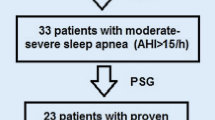Abstract
Purpose
Patients with obstructive sleep apnea (OSA) are at increased risk of cardiovascular and cerebrovascular disease (CVD) but it is unclear who are at greatest risk. We determined whether the inflammatory marker, C-reactive protein (CRP), could be a useful prognostic biomarker.
Methods
Adult patients referred for polysomnography (PSG) with OSA were studied. Serum CRP levels were measured using ELISA the morning after PSG. Validated CV events within 4 years of PSG were ascertained by linking to provincial research datasets.
Results
155 patients with OSA (AHI ≥ 5/h) had CRP measured. Median age was 53 and median AHI was 21/h. 10 patients (7.1%) suffered at least one event, but rates varied substantially by CRP (0/35 patients in the lowest quartile, and 7/39 in the highest CRP quartile). In the unadjusted analysis, patients in the highest CRP quartile (≥ 2.38 mg/L) were significantly more likely to suffer an event (odds ratio = 9.72 (95% CI 2.43–38.84), p = 0.001). CRP continued to be a significant predictor after controlling for multiple confounders. OSA severity and desaturation were not significantly associated with prospective events.
Conclusions
In this small preliminary study, OSA patients with an elevated CRP were significantly more likely to suffer a CVD event in the 4 years after PSG. Although these findings need to be confirmed in larger prospective cohorts, CRP may be useful in risk stratifying OSA patients to guide therapy or to identify patients that might be most appropriate for clinical trials of CVD prevention.

Similar content being viewed by others
References
Floras JS (2018) Sleep apnea and cardiovascular disease: an enigmatic risk factor. Circ Res 122:1741–1764
Hansson GK (2005) Inflammation, atherosclerosis, and coronary artery disease. N Engl J Med 352:1685–1695
Ridker PM (2003) High-sensitivity C-reactive protein and cardiovascular risk: rationale for screening and primary prevention. Am J Cardiol 92:17–22
Ridker PM, Everett BM et al (2017) Antiinflammatory therapy with canakinumab for atherosclerotic disease. N Engl J Med 377(12):1119–1131
Golbidi S, Badran M, Ayas N, Laher I (2012) Cardiovascular consequences of sleep apnea. Lung 190(2):113–132
Gozal D, Kheirandish-Gozal L (2008) Cardiovascular morbidity in obstructive sleep apnea: oxidative stress, inflammation, and much more. Am J Respir Crit Care Med 177:369–375
Kerr KF, Roth J, Zhu K et al (2017) Evaluating biomarkers for prognostic enrichment of clinical trials. Clin Trials 14(6):629–638
Johns MW (1991) A new method for measuring daytime sleepiness: the Epworth sleepiness scale. Sleep 14(6):540–545
Schwab RJ, Badr SM, Epstein LJ et al (2013) An official American Thoracic Society statement: continuous positive airway pressure adherence tracking systems. The optimal monitoring strategies and outcome measures in adults. Am J Respir Crit Care Med 188:613–620
Berry RB, Budhiraja R, Gottlieb DJ, Gozal D, Iber C, Kapur VK, Marcus CL, Mehra R, Parthasarathy S, Quan SF, Redline S, Strohl KP, Davidson Ward SL, Tangredi MM, American Academy of Sleep Medicine (2012) Rules for scoring respiratory events in sleep: update of the 2007 AASM Manual for the Scoring of Sleep and Associated Events. Deliberations of the Sleep Apnea Definitions Task Force of the American Academy of Sleep Medicine. J Clin Sleep Med 8(5):597–619
Peppard PE, Young T, Barnet JH, Palta M, Hagen EW, Hla KM (2013) Increased prevalence of sleep-disordered breathing in adults. Am J Epidemiol 177(9):1006–1014
Humphries KH, Gao M, Lee MK, Izadnegahdar M, Holmes DT, Scheuermeyer FX, Mackay M, Mattman A, Grafstein E (2018) Sex differences in cardiac troponin testing in patients presenting to the emergency department with chest pain. J Womens Health 27(11):1327–1334
Ramanathan K, Abel JG, Park JE, Fung A, Mathew V, Taylor CM, Mancini GBJ, Gao M, Ding L, Verma S, Humphries KH, Farkouh ME (2017) Surgical versus percutaneous coronary revascularization in patients with diabetes and acute coronary syndromes. J Am Coll Cardiol 70(24):2995–3006
McNicholas WT (2009) Chronic obstructive pulmonary disease and obstructive sleep apnea: overlaps in pathophysiology, systemic inflammation, and cardiovascular disease. Am J Respir Crit Care Med 180:692–700
Lavie L, Lavie P (2009) Molecular mechanisms of cardiovascular disease in OSAHS: the oxidative stress link. EurRespir J 33(6):1467–1484
Peres B, Hirsch Allen A, Fox N, et al (in press) Circulating biomarkers to identify cardiometabolic complications in patients with obstructive sleep apnea. Sleep Med Rev
Gottlieb DJ, Punjabi NM, Mehra R et al (2014) CPAP versus oxygen in obstructive sleep apnea. N Engl J Med 370(24):2276–2285
Funding
This work was funded by a CIHR Sleep Team Grant and the CSCN. Dr. Van Eeden is funded by a CIHR/GSK Professor in COPD.
Author information
Authors and Affiliations
Corresponding author
Ethics declarations
Conflict of interest
The authors declare that they have no competing interest.
Additional information
Publisher's Note
Springer Nature remains neutral with regard to jurisdictional claims in published maps and institutional affiliations.
Study was performed at the University of British Columbia, Vancouver, British Columbia, Canada.
Rights and permissions
About this article
Cite this article
Ayas, N.T., Hirsch Allen, A.J., Fox, N. et al. C-Reactive Protein Levels and the Risk of Incident Cardiovascular and Cerebrovascular Events in Patients with Obstructive Sleep Apnea. Lung 197, 459–464 (2019). https://doi.org/10.1007/s00408-019-00237-0
Received:
Accepted:
Published:
Issue Date:
DOI: https://doi.org/10.1007/s00408-019-00237-0




